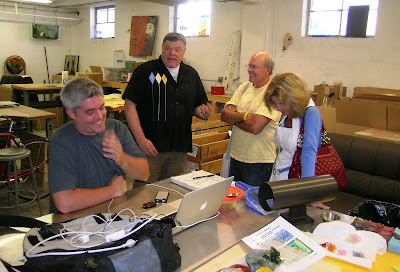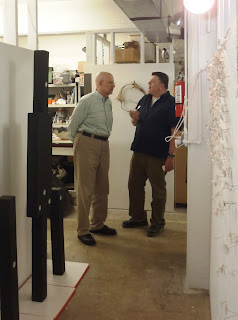Bullseye Glass had earlier this year opened their new facility in the California's Bay area near the Silicon Valley/Berkely/San Francisco corridor of Emeryville, CA. The place is called Resource Center Bay Area (RCBA) and this facility (the third of BE owned centers) offers workshops, supplies and a gallery.
 |
| RCBA, Bullseye Glass' new home in California. 4514 Hollis Street, Emeryville, CA |
One of the upcoming exhibits at the RCBA Gallery opens this coming Saturday, Aug 4, 2012. Titled: Facture: Artists on the Forefront of Painterly Glass, a number of the works were shown at BE's Portland gallery early this year in a show of the same name. The exhibit will showcase kilnformed glass paintings (mostly frit on sheet
glass) from the artists Abi Spring, Kari
Minnick, Martha Pfanschmidt, Ted Sawyer, Jeff Wallin, and WGS' Michael
Janis.
 |
Jeff Wallin Residue of a
Figure Study
kilnformed glass
|
from the BE website:
Facture: Artists at the Forefront of Painterly Glass is a group exhibition that explores many of the
concerns of contemporary painting, but does this exploration with glass.
Painting exists in a continuum with centuries of tradition while simultaneously
embracing aspects of sculpture, installation and collage. Painting today goes
beyond pigment on a surface; it is an approach to image making that encompasses
the ways in which a material is used to construct a work, how an artist
approaches a subject, and even how an image is conceived. The artists included
in Facture are constructing paintings using glass.
 |
Michael Janis Observation
of Signals
kilnformed glass and steel
|
Glass, unlike traditional
painting materials, is both surface and solid. Value and intensity can be
created on the suface as well as volumetrically. Paintings made from glass are
image and object; illusion and reality, and these artists, at the forefront of
this young method, are scratching at the boundaries of both.
 |
Martha Pfanschmidt Last Year
kilnformed and coldworked
glass
|
View the exhibition:
Bullseye Resource Center Bay Area Gallery, August 4 - October 20, 2012.



























































